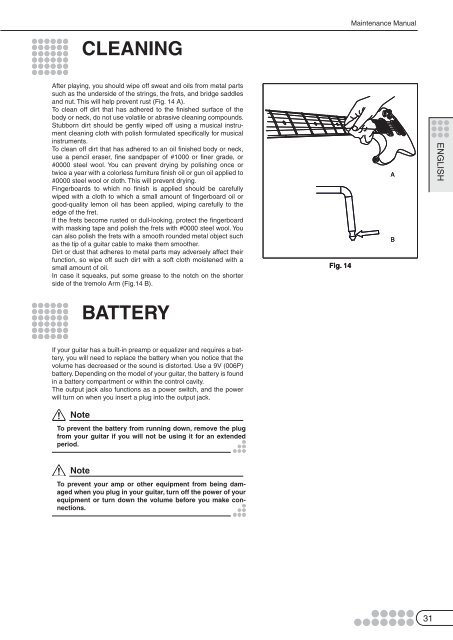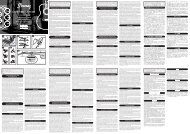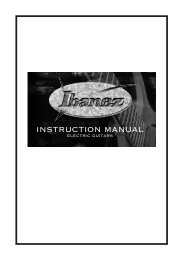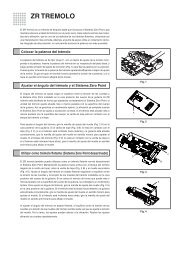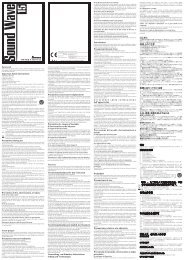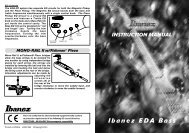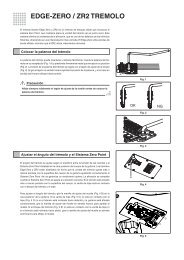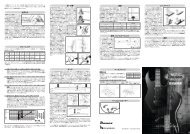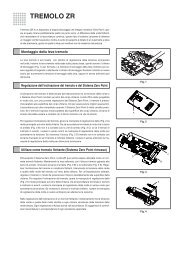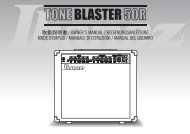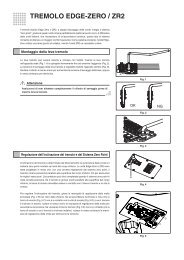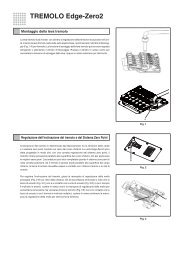Table of Contents - Ibanez Guitars
Table of Contents - Ibanez Guitars
Table of Contents - Ibanez Guitars
You also want an ePaper? Increase the reach of your titles
YUMPU automatically turns print PDFs into web optimized ePapers that Google loves.
CLEANING<br />
After playing, you should wipe <strong>of</strong>f sweat and oils from metal parts<br />
such as the underside <strong>of</strong> the strings, the frets, and bridge saddles<br />
and nut. This will help prevent rust (Fig. 14 A).<br />
To clean <strong>of</strong>f dirt that has adhered to the finished surface <strong>of</strong> the<br />
body or neck, do not use volatile or abrasive cleaning compounds.<br />
Stubborn dirt should be gently wiped <strong>of</strong>f using a musical instrument<br />
cleaning cloth with polish formulated specifically for musical<br />
instruments.<br />
To clean <strong>of</strong>f dirt that has adhered to an oil finished body or neck,<br />
use a pencil eraser, fine sandpaper <strong>of</strong> #1000 or finer grade, or<br />
#0000 steel wool. You can prevent drying by polishing once or<br />
twice a year with a colorless furniture finish oil or gun oil applied to<br />
#0000 steel wool or cloth. This will prevent drying.<br />
Fingerboards to which no finish is applied should be carefully<br />
wiped with a cloth to which a small amount <strong>of</strong> fingerboard oil or<br />
good-quality lemon oil has been applied, wiping carefully to the<br />
edge <strong>of</strong> the fret.<br />
If the frets become rusted or dull-looking, protect the fingerboard<br />
with masking tape and polish the frets with #0000 steel wool. You<br />
can also polish the frets with a smooth rounded metal object such<br />
as the tip <strong>of</strong> a guitar cable to make them smoother.<br />
Dirt or dust that adheres to metal parts may adversely affect their<br />
function, so wipe <strong>of</strong>f such dirt with a s<strong>of</strong>t cloth moistened with a<br />
small amount <strong>of</strong> oil.<br />
In case it squeaks, put some grease to the notch on the shorter<br />
side <strong>of</strong> the tremolo Arm (Fig.14 B).<br />
BATTERY<br />
If your guitar has a built-in preamp or equalizer and requires a battery,<br />
you will need to replace the battery when you notice that the<br />
volume has decreased or the sound is distorted. Use a 9V (006P)<br />
battery. Depending on the model <strong>of</strong> your guitar, the battery is found<br />
in a battery compartment or within the control cavity.<br />
The output jack also functions as a power switch, and the power<br />
will turn on when you insert a plug into the output jack.<br />
Note<br />
To prevent the battery from running down, remove the plug<br />
from your guitar if you will not be using it for an extended<br />
period.<br />
Note<br />
To prevent your amp or other equipment from being damaged<br />
when you plug in your guitar, turn <strong>of</strong>f the power <strong>of</strong> your<br />
equipment or turn down the volume before you make connections.<br />
Fig. 14<br />
Maintenance Manual<br />
A<br />
B<br />
31<br />
ENGLISH


